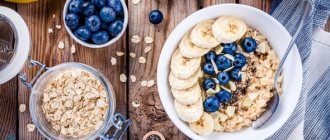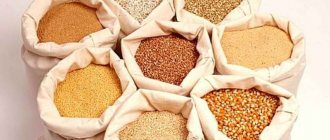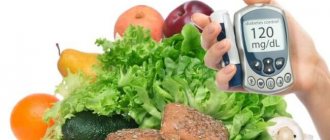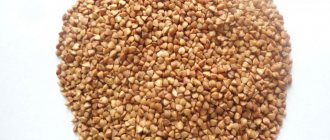Diabetes mellitus requires strict adherence to a special diet. For the menu to be not only healthy, but also nutritious, the diet should include porridge. Corn is considered one of the most delicious and healthy cereals for diabetics. Properly prepared corn porridge for diabetes will please not only the stomach - with moderate consumption of the product, you don’t have to worry about sudden surges in blood sugar.
Can people with diabetes eat corn?
The sweet cob contains sugar and starch, and therefore increases the glycemic level. The benefits and harms of this product for diabetes depend on the method of preparation and the amount eaten. Moderate consumption of maize or corn porridge helps replenish vitamin deficiency.
Patients with insulin-dependent diabetes should know that 21 g of corn grits contains 1 bread unit. The energy value of 100 g is 337 kcal. However, a fairly high dietary fiber content prevents a rapid increase in sugar.
Corn does not contain gluten, so diabetics with a tendency to allergic reactions can include porridge in their diet as a side dish. For gestational diabetes in pregnant women, it is better to replace refined rice porridge or pasta with hominy. This healthy dish is rich in macro- and microelements.
Important! It is worth excluding cereals in case of individual intolerance, stomach and duodenal ulcers, thrombophlebitis.
Contraindications
Despite the benefits, corn porridge has contraindications:
- Individual intolerance to cereals. An allergic reaction to corn occurs in one in a hundred cases. If symptoms appear after consumption: itching, red spots, swelling, it is recommended to take an antihistamine and consult a doctor.
- Stomach ulcer. Coarse grains are contraindicated for patients with serious gastrointestinal injuries. And soft flakes are not suitable for diabetics.
- Predisposition to thrombophlebitis.
In other cases, properly prepared porridge will only be beneficial for a weakened body.
Factors influencing the glycemic index
Corn can be harmful for diabetes only if its glycemic index is not taken into account. This indicator varies depending on the method of preparing the cereal, its grinding and combination with other products:
- hominy on water has the lowest GI - 42;
- canned grains – 58–60;
- boiled cob – 70;
- cereal – 85.
Important! Products with a GI over 70 units are considered fast carbohydrates.
Corn porridge for diabetes
Maize groats have an average GI. Accordingly, for type 2 diabetes mellitus, just such a product can be included in the diet. Boiled and canned grains can be consumed as an additional ingredient in vegetable salads. Young boiled cobs are consumed in large quantities by diabetics and are often not recommended. High GI corn flakes are contraindicated for obese people.
Combination of corn with products
Diet therapy for diabetics with type 2 diabetes should be aimed at reducing body weight. Therefore, you can combine a carbohydrate cereal product with protein foods. It is recommended to prepare hominy porridge from maize flour. Out of habit, the dish will seem bland. However, in combination with boiled or stewed lean meat, porridge will become a tasty side dish that brings benefits. The dish can be served with hard cheeses.
Corn grains are added to green vegetable salads. The product goes well with:
- legumes;
- spinach;
- asparagus;
- cauliflower;
- broccoli;
- green onions;
- lettuce salad
Corn grains go well with oatmeal cooked in milk. This dish can diversify the menu, but is not recommended for frequent inclusion in the diet.
Groats
Corn grits are great for preparing a variety of dishes: porridge, hominy, soup, casseroles, filling for baked goods. It is produced through special processing of corn grains. There are the following types of cereals:
- polished – has different sizes and shapes of grains;
- large – used for making flakes and puffed grains;
- fine (flour) – crispy sticks are made from it.
A very popular dish is mamaliga made from corn. It once became widespread due to the fact that the Turks did not demand tribute for it, and was much tastier and more nutritious than millet hominy. In Italy, this dish was called “polenta”.
Benefits of corn for diabetes
Despite the fact that the cereal is quite high in calories and has a GI above average, you should not give it up if you have diabetes. The beta-carotene content in grains helps improve vision and strengthen blood vessels. Other useful substances in the composition include:
- Silicon. Participates in the absorption of minerals and vitamins, reduces the risk of cardiovascular pathologies, strengthens bones.
- Thiamine (B1) prevents neurological disorders, improves the functions of the cardiovascular and digestive systems.
- Riboflavin (B2) strengthens the immune system and helps break down fats and carbohydrates.
- Choline (B4) serves to maintain energy metabolism.
- Pantothenic acid (B5) normalizes fat and water metabolism.
- Folates (B9) are essential for the growth and development of the circulatory and nervous systems.
- Vitamin E ensures the functioning of the immune system, strengthens blood vessels and muscles.
- Biotin (B7) is useful for diabetics and takes part in all metabolic processes.
- Nicotinic acid (PP) prevents blood clots and strengthens blood vessels.
- Niacin (B3) normalizes the functioning of the nervous system and brain, participates in the breakdown of fats and carbohydrates.
- Vitamin K is involved in blood clotting processes.
- Potassium regulates water balance and heart function.
- Magnesium affects blood vessels and prevents hypertension and stress.
- Phosphorus is essential for cell repair.
- Sulfur is involved in metabolic and regeneration processes.
- Aluminum plays a role in the process of repairing connective tissue.
- Copper improves immunity and improves the functioning of the digestive system.
- Calcium ensures healthy bones.
Benefits of corn for diabetes
Daily consumption of cereal porridge cooked in water will help eliminate cholesterol and toxins. The high fiber content in a diabetic side dish helps strengthen the walls of blood vessels, remove excess fluid, and normalize intestinal function.
Eating corn dishes for diabetes
Patients are advised not to consume sweetened corn flakes. However, a delicious dessert can be prepared at home. The recipe for the delicacy is simple:
- corn flour – 30 g;
- egg – 1 pc.;
- vegetable oil – 10 ml;
- milk – 15 ml.
Combine milk with butter and bring to a boil, pour flour into it, cool to 50 degrees, add an egg and beat with a blender. The resulting mixture is passed through a bag and baked at moderate temperature. You get healthy corn sticks. Instead of sugar, a sweetener for baking (stevia) is added.
You can make tortillas from flour. This is a healthy alternative to bread. To prepare, knead the dough in water. For 2 cups of flour you will need 1 cup of hot water. The dough will be crumbly, since the flour contains no gluten or gluten. It is formed into flat cakes approximately 1 cm thick and fried in a frying pan. It is recommended to use a Teflon-coated frying pan so as not to use vegetable oil.
Corn porridge
To prepare maize porridge you will need 200 g of cereal and 600 ml of lightly salted water. Cook the side dish for about 40 minutes over low heat. To prevent the porridge from burning, it is cooked in cast iron. After cooking, cool.
For taste, you can prepare a sauce based on parsley, cilantro, garlic and olive oil. The ingredients are mixed in a blender and the prepared seasoning is poured over the porridge. This dish is suitable for people with physical inactivity. The high fiber content prevents carbohydrates from quickly penetrating into the bloodstream. Therefore, the risk of blood sugar spikes is reduced. It is useful to give to children as a side dish with protein meat products.
The benefits and harms of cereals
Corn grits contain a large amount of carbohydrates, which take a long time to break down into simple sugars. The beneficial substances in cereals will provide a person with sufficient energy for work and recovery. Glucose from corn is absorbed slowly and does not cause sudden spikes in blood sugar.
For patients with type 2 and type 1 diabetes mellitus, corn porridge is useful for the following reasons:
- Blood sugar levels are normalized. Coarse grains have a medium glycemic index, so glucose is absorbed relatively slowly.
- Tones the patient's body. For type 2 diabetes, the patient follows a strict diet. With a lack of vitamins and minerals, a person feels a loss of strength. Corn porridge replenishes the body with essential microelements.
- Normalizes the functioning of the gastrointestinal tract. Finely ground corn porridge coats the walls of the stomach and relieves pain.
For type 2 diabetes, the patient is prescribed a strict diet. To quickly lose weight without feeling discomfort, it is recommended to eat vegetables and grains. Corn grits were unfairly forgotten in Russia and appeared in stores at the end of 2000. Allergen-free cereals are safe for children from the first year of life and are suitable for people with serious diseases of the pancreas and gastrointestinal tract.
Canned corn
When buying canned corn grains, you need to pay attention to the composition. Apart from sugar, salt and the grain itself, nothing else should be included there. Despite the fact that only a fifth of the biologically active substances remain during canning, there are still benefits from the product. The grains contain fiber, vitamins B, E, tryptophan, and magnesium.
It is not recommended to be consumed as an independent dish. A salad made from boiled chicken breast, nuts, hard cheese and canned corn is a healthy snack. Season the salad with vegetable oil.
Canned corn
For patients losing weight, it is recommended to prepare a salad from low-fat ham or sausage (50 g), Chinese cabbage (150 g) and canned corn (3 tablespoons). Chopped greens are added to the dish and seasoned with olive oil.
Boiled corn
Boiled young ears of corn have a high GI, so you can eat no more than two of them. It is preferable to cook the cobs with stigmas in salted water. The product is saturated with a healthy decoction that normalizes sugar levels. There are options for cooking cobs in a slow cooker. This saves time and preserves more nutrients.
Boiled corn has a high GI
It is better not to include overripe grains in the diet. The rough shell of the grains is difficult to digest. As a result, instead of benefit, you can get stomach problems and flatulence. Old cobs need to be cooked for a very long time to avoid digestive problems.
Summarize
Despite the fact that corn is high in calories and contains a lot of carbohydrates, it is recommended as an additional dish for patients with hyperglycemia. The rich composition of the cereal ensures the normal functioning of all organs and systems for diabetics and replenishes the deficiency of essential organic substances.
Interesting:
- What cereals can you eat if you are diagnosed with type 2 diabetes mellitus, types of cereals that are considered beneficial for the diet for diabetes
- Features of preparing cottage cheese casserole for diabetics
- How does taking sauerkraut affect the body during diabetes, what are its benefits and harms for diabetics
- Methods for preparing sweets for diabetics so that they do not cause harm
- Subtleties of cooking vegetables for diabetes: cooking options, characteristics of vegetable ingredients of the dish
- Simple recipes for millet porridge for diabetes: the benefits and negative effects of millet on the body, the composition of the cereal
- Is it possible to eat wheat porridge if you have type 2 diabetes mellitus or not, beneficial properties, contraindications, chemical composition and side effects
Stigma
The thin threads that cover the cob are actively used in folk medicine in the fight against diabetes. The extract of these stigmas has choleretic properties, reduces the viscosity of bile and increases blood clotting.
All the most useful things are in this “hair”
To prepare a healing decoction, you need to take stigmas from three cobs. The fresher they are, the greater the effect of herbal medicine. The hairs are thoroughly washed in running water and poured with boiling water. Then they need to be boiled for a quarter of an hour. The broth is cooled, filtered and taken 3-4 times a day before meals. After a week of taking the product, you should take a break - do not take it for the same amount of time. Then the cycle repeats. It is important that the intervals between doses are the same - this guarantees a positive treatment result. Glucose levels will be normal and fairly stable.
Of course, corn porridge for diabetes is not a panacea, but its regular moderate consumption, subject to cooking technologies, helps maintain blood sugar levels at a normal level in both types of diabetes. You just need to take into account the glycemic index of various products made from corn, try not to combine them with fats and monitor portion sizes.










